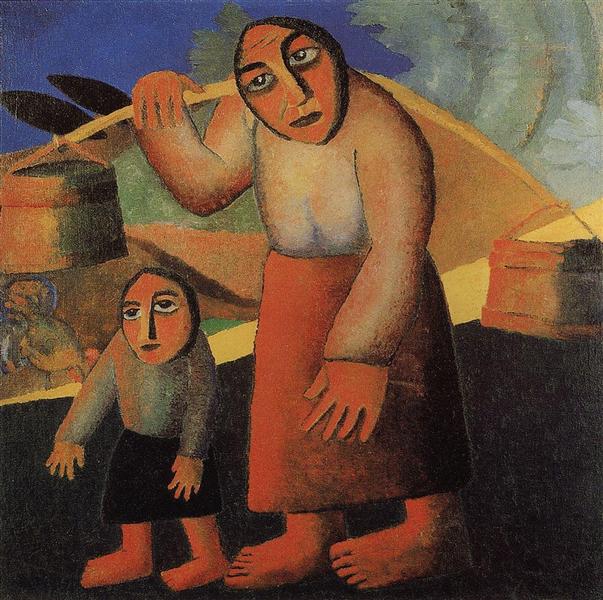Description
Kazimir Malevich, the famous Russian painter and pioneer of suprematism, found in his peasant work with cubes and a child of 1912 a peculiar way of expressing the rural life of his time. This painting, chronologically located in a critical stage of Malevich's career, is part of the period in which the artist was in transition towards the suprematist style that would make it worldwide known. More than a simple representation of rural life, this work is erected as a preamble to its abstract exploration of shapes and colors.
The composition of the work is, at first glance, simple, but expresses a latent complexity. In it, a robust female figure, clearly identifiable as a peasant, is represented standing, ostensibly carrying two cubes. Beside her, a small child, with a serene countenance, accompanies her. The facial details of both characters lack specificity, a characteristic that immediately refers us to the Malevich technique in which the figurative aspects are almost simplified to the geometric to underline the universality of the subject.
The colors used in the paint are vibrant and contrasting. The peasant wears a red skirt and a white blouse that stand out against the green and blue background. The choice of red is not fortuitous; This color symbolizes both the vitality and hard life of the field, central elements in Malevich's work. Cubes, painted in metallic tones with gray and white insinuations, reflect attention to detail in everyday objects that, like the human figure itself, are represented in a simple but expressively represented.
The background of the paint, a mixture of deep green with blue spots, points to a bucolic rural environment. However, the landscape itself is not detailed, but only serves as a context, an abstract curtain that gives prominence to the main subjects. This technique is indicative of Malevich's search for reducing paint to its most essential components, experiencing with the limits of realism before making the complete jump to abstractionism.
The work also resonates with a sense of movement contained in the positions of the characters. The peasant seems to be in a moment of quiet activity, perhaps transporting water, while the child maintains a more static posture. This duality resonates with rural life itself, that Malevich knew well: a work and rest routine, effort and stillness.
Peasant with cubes and a child is a window to a formative and transformative period in Malevich's career. His technique in this painting anticipates the revolution that would come with his suprematism, where geometric shapes and pure colors would govern the canvas. This work is a bridge between its symbolic phase and abstraction, capturing in its graphic simplicity a deep sense of Russian peasant life.
Although it is not as well known as his most radical suprematist works, peasant with cubes and a child offers valuable clues about Malevich's artistic evolution. It is a testimony of its ability to distill the human experience in fundamental forms and colors, while preparing the land for its subsequent explorations, where geometric shapes and color would become its absolute protagonists. This painting, So, it is not only a representation of rural life, but a statement about the universality of human experience, a topic that would continue to explore to his last works.
KUADROS ©, a famous paint on your wall.
Hand-made oil painting reproductions, with the quality of professional artists and the distinctive seal of KUADROS ©.
Art reproduction service with satisfaction guarantee. If you are not completely satisfied with the replica of your painting, we refund your money 100%.

